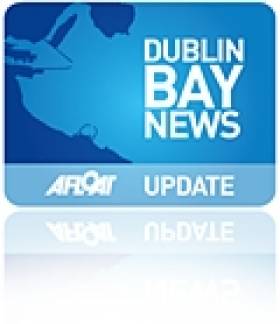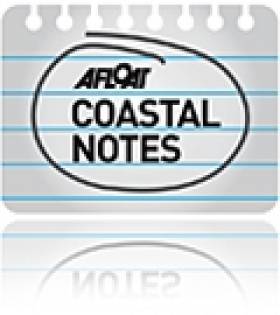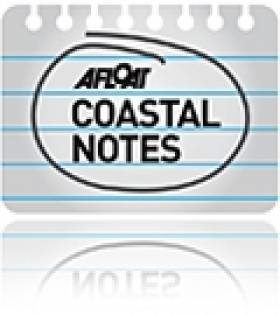Displaying items by tag: National Maritime Museum of Ireland
1916 Lectures & Exhibition Commemorates Easter Rising
#1916Lectures – A series of 1916 Easter Rising themed lectures on the lesser known maritime aspects of the rising accompanied by a specially produced exhibition will be held in the National Maritime Museum of Ireland, Dun Laoghaire.
As its contribution to the 1916 commemorations, supported by Dun Laoghaire Rathdown County Council and the Ireland 1916 – 2016 Centenary Programme, the Maritime Institute of Ireland (founders of the NMMI) is presenting seven lectures at the museum venue located in the Old Mariners Church, which is only minutes away from the DART and off Dun Laoghaire’s main street.
1916 Exhibition: The exhibition will tell the story of the 1916 Rising from a maritime viewpoint and is to include a display of a gun from the Asgard and a map showing the Helga's movements in 1916.
1916 Lectures: The maritime dimension to the Easter Rising commenced in 1914 and two lectures will examine the role of the Asgard and the lesser known yacht Kelpie in running arms to the Irish Volunteers into Howth and Kilcoole.
The story of the Aud from its departure from Lubeck to its scuttling off the Daunt Rock, plus the ill-fated landing of Roger Casement from U-19 on Banna Strand and the shelling by the Dun Laoghaire based HMS Helga of Boland’s Mill and Liberty Hall during the Rising will be the focus of two further lectures.
The working conditions of Seamen and the prevailing social divisions between Kingston/Dun Laoghaire seafarers in 1916 will also be explored.
Concluding the series will be a tribute to the immense contribution of the noted historian Dr John de Courcy Ireland to the little known maritime history of the Rising when he first penned ‘The Sea and the Easter Rising 1916’.
The publication was timed for the 50th anniversary of this historic event which heralded the birth of the new Irish Nation.
Inaugural 1916 Lecture: ASGARD on the Road to the Rising and Beyond, will be held on 15th March (7:30 pm - 9:30 pm)
The presenter, Pat Murphy a well-known yachtsman who has broadcast extensively on RTE Radio One’s maritime programme ‘Seascapes’ explores the role of the Asgard in the run up to the Rising.
Below is a list of the following lectures
April
The Silent Shore, The AUD, Roger Casement and Banna Strand – 5th April (7:30 pm - 9:30 pm)
The AUD and the HELGA in the 1916 Rising – 26th April (7:30 pm - 9:30 pm)
May
Working Conditions of Seamen in 1916 – 12th May (7:30 pm - 9:30 pm)
Conor O'Brien, KELPIE and the 1914 Gun Running – 19th May (7:30 pm - 9:30 pm)
Kingstown: A Divided Seafaring Town – 26th May (7:30 pm - 9:30 pm)
June
Dr John de Courcy Ireland: A Tribute to a Maritime Historian – 9th June (7:30 pm - 9:30 pm)
Further information on opening exhibition times and updates are available from the NMMI website: www.mariner.ie
To contact: Tel: (01) 214 3964 and by email: [email protected]
Peter Pearson Photo Exhibition of Sea & Stone
#PeterPearsonPhotos - Peter Pearson, historian, conservationist and artist has a photo exhibition currently running throughout the summer (until 31 August) in National Maritime Museum of Ireland, Dun Laoghaire, writes Jehan Ashmore.
The photo exhibition held daily (11am-5pm) is held on the gallery floor of the restored former Mariner's Church on Haigh Terrace, close to the Royal Marine Hotel.
Signed books of the artist are also available from the museum's gift and book shop. For further information, contact the museum or the artist: 053 912 8935 and 087 637 1646
Click the link to the National Maritime Museum website, noting the photograph of the artist and an example of his work depicting the Sealink / British Rail car-ferry St. Columba berthed at Dun Laoghaire Harbour's Carlisle Pier. Note the quayside cranes (for the older 'mail'-boats), which suggests this painting was taken in her early career on the Irish Sea.
In recent years the Carlisle Pier ferry terminal was demolished. The site still features the ferry linkspan's operators booth that operated the vehicle ramp and lift-bridge for yacht access to and from the Royal St. George Yacht Club. In the painting the bridge is in a raised position obscuring the booth. These days cruise ships call instead, the most recent visitor was the cruiseship-yacht Wind Surf.
The Danish built St. Columba was custom built for the Holyhead route and entered service in 1977. She remained on the Irish-Welsh link as the last conventional car ferry until replaced by the revolutionary Finish built catamaran HSS Stena Explorer introduced in 1996. The fast-ferry operates albeit only on a seasonal basis and from St. Michael's Wharf adjoining the marina.
Lectures: Marconi - Heritage of Early Transatlantic Radio Communications
#MarconiLectures – Marconi, will be the theme for a series of lectures held in the National Maritime Museum of Ireland, Dun Laoghaire on 22 February.
Each of the three talks (3:00 -6:30 pm) are to be presented by the Radio Officers' Association, topics are listed below.
'The Collections of the Maritime Museum, Dun Laoghaire' (Seamus O'Connor)
'Marconi's Wireless Stations at Clifden and Letterfrack' (Shane Joyce and Michael Gibbons)
'The Making of BBC Coast, with Irish Navy Personnel, on Marconi's Radio Station at Clifden' (Frank McCurry and Tom Frawley)
All are welcome to attend. To book contact: Colman Shaughnessy, Radio Officers Association or by phone: 086 2489319 in addition to emailing: [email protected]
To cover the costs, voluntary donations of €5 would be appreciated.
Children’s Art Competition: Ships, Boats and things that Float!
#ChildrensArt - The National Maritime Museum of Ireland, Dun Laoghaire, is inviting all 5 to 12 year olds to take part in an art competition.
So get involved by gathering an A3 size piece of paper, watercolours, crayons, pencils or magazine cutouts, whatever makes you feel creative, and let your imagination flow!
Entries can be sent to the museum situated in the former Mariners Church on Haigh Terrace or dropped in the front desk. Please make sure you put your name, age and a contact number of email address clearly legible on the back of the painting.
If you are sending your contribution from a school, add the name of the school and your teachers' name and contact details as well.
Winners will be selected at the end of February. Easons Dun Laoghaire has kindly sponsored prizes. The winning pictures will be exhibited alongside their historic predecessors in the museum's upcoming exhibition of maritime paintings and prints from the Maritime Institute of Ireland's own collection.
Gathering of This Island Nation Explores Our Maritime Heritage
#MaritimeHeritage - The National Maritime Museum of Ireland (NMMI) in Dun Laoghaire recently hosted a two-day Maritime Heritage Gathering funded by the Department of Arts, Heritage and the Gaeltacht and supported by Dun Laoghaire Rathdown County Council and Gathering Ireland 2013.
Welcoming more than 100 participants from among 60 organisations from the island of Ireland and the UK was An Cathaoirleach Carrie Smyth of Dun Laoghaire-Rathdown County Council.
The diversity of participants ranged from maritime museum managers, historians, authors, genealogists, deep-sea divers, archaeologists, shore built heritage and inland waterways enthusiasts, former dockers, historic boat restorers, community development groups and Government agencies.
The maritime gathering recognised the need to share the common objective of raising the profile of a collective maritime heritage and highlight its tourism potential. It is the determination of locally funded museums, historical societies and individuals to preserve the historic, cultural and folklore memory of Ireland's 3,500 mile coastline, despite current economic circumstances, with the assistance of State agencies was emphasized.
The importance of making all things maritime more accessible to school children linking museums with local heritage groups, sailing clubs and utilising the internet and 3-D visual technology to develop virtual museums featured amongst a host of ideas from six expert groups.
Participants agreed to co-operate to develop national and trans-national projects through a common Maritime Heritage Platform sharing resources and supporting one another. Workshop discussion groups provided opportunities to exchange ideas under the following core topic headings:
• Future Development of Maritime Museums in Ireland
• Preservation of Historic Ships and Traditional Boats
• Developing the Research Capabilities of Irish Maritime Libraries and Archives
• Maritime Tourism Initiatives, Marketing and Communications
• Co-operation in Maritime Heritage Networks, Joint Projects and Special Exhibitions
Mr Jim Deenihan TD, Minister for Arts, Heritage and the Gaeltacht, said that historically Ireland had ignored its maritime heritage, but this is rapidly changing and the rising interest in genealogy actively promoted by his department through www.irishgenealogy.ie has created a new window of opportunity for positive developments in the maritime field.
The Minister was particularly impressed with the pro-active approach of the National Maritime Museum (home of the Maritime Institute of Ireland) in preserving its historic artefacts and unique 4,000 volume maritime library and archive. The fact that so many representatives came together for the very first time to find workable solutions to promote maritime heritage indicated a very strong statement of intent from the maritime heritage sector, which his department recognises.
Last year the National Maritime Museum was officially reopened by the museum's patron President Michael D. Higgins. The former Mariners Church where the museum is located has a primary objective in the promotion and development of a greater awareness of Irish maritime heritage, our historical seafaring figures and the role of shipping.
For six years the Mariners Church underwent an extensive structural renovation programme financed by Government grant aid. The renovation of the building has ensured that its distinctive architectural features and valuable artefacts and library are preserved for generations to come.
Maritime events, lectures, guided tours for schools, adult societies and special interest groups occur regularly. The venue also hosts civic, cultural and corporate events all year round. For further information visit: www.mariner.ie
Maritime Museum Table Quiz & Wine Tasting Fundraiser
#TableQuiz- Have fun while raising funds for the National Maritime Museum of Ireland, Dun Laoghaire, where a Table Quiz & Wine Tasting event is to be held in the Eblana Club, next Thursday 10th October.
The evening event (starting at 7.30pm) begins with wine-tasting by Mitchells of Glasthule. An hour later the table quiz gets into action and the bar will also be open.
Eblana Club is located on Eblana Avenue which is off the town's Marine Road. Tickets cost €10 per person / €40 per table and payable at the door.
As this event is not currently on the NMMI's website, for further details email: [email protected] or tel: (01) 2143 964.
For other information about the museum which has a cafe, gift shop and library (members-only) plus opening times visit: www.mariner.ie
One Year On... Since Re-Opened National Maritime Museum
#OneYearOn – The National Maritime Museum of Ireland in Dun Laoghaire yesterday celebrated its first anniversary after last year's 'official' re-opening ceremony by President Michael D. Higgins following a €4m renovation, writes Jehan Ashmore.
Earlier this year the museum which is run by the Maritime Institute of Ireland were delighted to receive an award from the Industrial Heritage Association for 'Best Museum / Restored Site 2012'.
Among the most popular exhibits is the old optic of the Baily Lighthouse, Captain Halpin and the Great Eastern and the story of the RMS Leinster torpedoed on the Kish Bank. For more abou the exhibits visit the Video Virtual tour click HERE noting to click on map to begin. Better still make a visit to the museum in person!.. which is open 11am-5pm everyday until the end of July.
Currently on is display is the 'Bratacha Flags & Emblems Exhibition' which certainly adds a splash of colour with many nations represented amongst the museums existing shipping company house-flags that are draped around the contrasting dark timbered balcony.
Originally the building completed in 1836 was home to the Church of Ireland Mariners Church built of granite quarried from Dalkey that of course built the nearby harbour. The museums exhibits are surrounded by beautiful stained glass windows and the timber ceiling.
Such surroundings make a visit apt considering the building with its past to worshipping mariners is one of the last such structures left in the world.
The restored museum featured in a lavishly illustrated publication 'NEW LIFE for Churches in Ireland – Good Practice in Conversion and Reuse' which is available for sale in the museum's Gift Shop. Also stocked are a wide range of nautical-related merchandise including framed print scenes of the harbour, greeting cards and much more.
There's also a café serving hot snacks and where stain-glass windows which were also installed during the renovation plus a Wi-Fi hot-spot. Noting, the museum is mostly wheelchair accessible.
There are plans to reintroduce the library with its impressive range of historical books including the Lloyds Register of Shipping collection in the Lawlor Room, named after Col. Anthony Lawlor, the founder of the Maritime Institute of Ireland (M.I.I.) in 1941.
Another notable leading figure of the institute, was the late Dr. John de Courcy Ireland, who was widely regarded as the father of Maritime Ireland.
A group of volunteers from the institute as well as a team funded by the Community Employment Scheme of the Department of Social Protection provide staff duties that include guided group tours.
The museum welcomes new volunteers, so if can you assist in any way?... even if it's just a few hours a week call the museum on (01) 2800 969. For further information visit: www.mariner.ie
Mariners’ Church featured in New Life for Churches in Ireland
#MARINERS CHURCH – NEW LIFE for Churches in Ireland – Good Practice in Conversion and Reuse is the title of a new multi-authored publication. Among the diverse range of 17 case studies is the former Mariners' Church, Dun Laoghaire, which as the National Maritime Museum of Ireland was officially reopened in June by President Michael D. Higgins.
At the reopening President Higgins said "This magnificent old Mariners' Church is one of the few large mariner churches in the world. It is a beautiful building...it is great to raise awareness of our maritime heritage".
Writing about the former Church of Ireland place of worship, Peter Pearson details the history of the building erected in 1836 to the designs of Joseph Welland for the benefit of the many sailors who were based on Royal Navy vessels in the then new Kingstown Harbour.
Accompanying the case study are photographs including those taken by Jehan Ashmore on the day of the reopening to illustrate the building which underwent substantial conservation and renovation work (between 2005-2011) by James Slattery Architects.
Asides the Mariners' Church there are further case studies from throughout the island of Ireland, amongst them Elmwood Hall in Belfast, Carlingford Heritage Centre, Triskel Christ Church, Cork and St. Werburgh's Church, where last month the book had its Dublin launch.
Also featured are more modest but nevertheless important schemes, followed by a section featuring projects where work is underway but not complete. Schemes include the conversion of churches for domestic as well as cultural, commercial and community use. Each of these case studies are underpinned by an analysis of our ecclesiastical heritage, a flow chart to stimulate discussion on underused churches and an explanation of conservation principles and statutory responsibilities.
The 144-page publication is produced by the Ulster Historic Churches Trust and edited by Paul Harron. Among the other contributors are Edward McParland, Grainne Shaffrey, Patrick Shaffrey, Michael O'Boyle and Alistair Rowan. The book has a wealth of full colour photographs, drawings and illustrative material throughout.
Retail prices are €15 / £12 (softback) and €20 / £18 (hardback) and they can be purchased from the following stockists:
DUN LAOGHAIRE: Maritime Museum Gift Shop, National Maritime Museum of Ireland, Mariners'Church, Haigh Terrace (note: Open 11am-5pm Everyday)
DUBLIN: RIAI Bookshop / Irish Georgian Society (both on Merrion Square), Dublin Civic Trust, Castle St. (beside Dublin Castle) and St. Michan's Church office
BELFAST: Good Book Shop, Donegall St. (beside St Anne's Cathedral)
or available through Amazon.
ISBN: 978-0-9573791-1-4
Museum Festive Concert: Il Coro Italiano di Dublino
#MUSEUM CONCERT – Getting into the festive spirit on Saturday 1 December will be a concert of opera choruses, folk songs Christmas music and distinguished soloists performed by "Il Coro Italiano di Dublino" in the National Maritime Museum of Ireland, Dun Laoghaire.
Il Coro Italiano di Dublino was founded in 1986 by Dr. Rosa Maria Chicco-Ferraro, Deputy Head of Mission at the Italian Embassy in Dublin at that time. The present name of the choir was adopted in 2002.
Tickets cost €10 each for the concert that starts at 7.30pm in the renovated surroundings of the former Mariners Church. For further events and daytime visiting hours (including Mondays) of the museum visit: www.mariner.ie
Museum FUNdrasier: Crazy Bingo Night
#MARITIME MUSEUM – Help to raise funds for the National Maritime Museum in Dun Laoghaire as a Crazy Bingo Night with drag-queen Annie Balls is to take place on Saturday 17 November.
Will you be the lucky one to win a money prize or a Booby prize!...find out by attending the event held in the Sallynoggin Inn (doors open 8pm).
Tickets costing €10.00 include 5 games of Bingo and are available from the venue's off-license contact Tara or Katie on 01 214394 or from the museum on Haigh Terrace off Georges Street.
As for the museum which is mostly wheelchair accessible, visiting hours (Everyday) are 11am-5pm. Asides the many exhibits on display, there's a museum shop, a coffee dock and a Wi-Fi hotspot. For further information call 01 2800969 and www.mariner.ie






































































